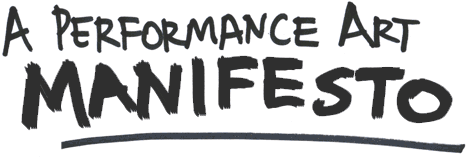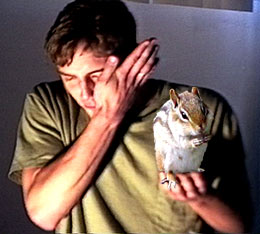
1. Working Definition of Performance Art
A performance art piece is an authentic action performed before an audience, framed as performance art, and belonging more readily to the performance art genre than to any other genres.
2. Identifying It: Performance Art is Performance Art
In performance art, a performance art action is framed as performance art, and not as drama, dance, music, "the performing arts", film, video, painting, sculpture, mime, poetry, spoken word, oratory, circus arts, etc., although these and other art elements may sometimes appear similar to performance art, and they can surely be appropriated by performance art.
Performance art has an art history with lineage and evolution. Mixing two genres together does not necessarily give rise to performance art. However, there is no "usual" means or technology for achieving expression in performance art. Where dance usually employs bodies, film usually employs light, and painting usually employs paint, performance art can employ anything, or re-work the means of other genres to Dadaist extremes like bodies through a projector.
More than any other performative art form, performance art is defined by the presence of a performer, an audience, and a performer's action. Dance doesn't require an audience for dancers to dance; drama doesn't need an audience for actors to act. Without an audience, however, performance art ceases, becoming just action.
 Performance art is sometimes compared to Drama because both genres employ action,
but often they are dissimilar. First, performance art often
lacks "acting"—performers
may not "pretend" to be characters in other times and places who convey stories.
Performance artists
may address the audience directly, eschewing the fourth wall.
When performing, performance artists may use objects as expected like an actor,
but also invent bizarre new uses
for them: where an actor might drink from a water glass, the glass to a
performance artist might be a car, for example, or a toilet,
or the performer's mother, or all three, figuratively or literally,
sabotaging Drama's formula of Aristotelian mimesis.
Performance art is sometimes compared to Drama because both genres employ action,
but often they are dissimilar. First, performance art often
lacks "acting"—performers
may not "pretend" to be characters in other times and places who convey stories.
Performance artists
may address the audience directly, eschewing the fourth wall.
When performing, performance artists may use objects as expected like an actor,
but also invent bizarre new uses
for them: where an actor might drink from a water glass, the glass to a
performance artist might be a car, for example, or a toilet,
or the performer's mother, or all three, figuratively or literally,
sabotaging Drama's formula of Aristotelian mimesis.
And unlike Drama, a performance art piece may
lack any conscious narrative. There may be no speech, gesture, or movement. If a performance artist
makes a voice like a chipmunk, the performer is not necessarily pretending
to be, or imitate, a chipmunk—it may simply be the performance artist
speaking like a chipmunk, or the chipmunk-speak may have
no consciously rational reason for being used at all—performance artists
have been known to recite incoherent texts for hours.
For this reason, performance art has the ability to rewrite, undo, or recode
the relationship between signifiers and what is signified,
changing the underlying foundation and power of language.
Where language is historically phallogocentric (emanating from the power of the penis),
performance art enables the performer to create new languages appropriate
to his, her, or its ontological, sexual, and other creative organs.
It then becomes the art task of the audience to learn the language
of the performer, and in that symbiotic work, question the world and our place in it.
Here is one test for performance art: if an action can be reframed so it is immediately recognizable as belonging to a historical genre that is not performance art, then the action is probably not performance art.
Here is another: see or do enough performance art, and you'll know what it is (and isn't).
3. Authenticity: Evidence of an Authentic Performance Art Action is Not the Action Itself
A performance art action, as it unfolded, was authentic in space and time. If an action
was recorded using technology, the record's contents are not the same as the action that unfolded.
If a record of a performance art action is played or shown, the playing/showing
is an action in itself, but this action is not necessarily performance art.
Debris, art objects, and other remnants from a performance art action that unfolded
can serve as sculpture, memory, evidence, archeological artifacts, choreographies
for future performances, etc., but they are not in themselves performance art.
4. Corollaries:
A record of an authentic performance art action can only simulate the action that unfolded.
Performance art simulations aren't performance art (unless appropriated by performance art).
To witness an authentic performance art action, the audience should be present
when and where the action unfolds (unless not having the audience present when and/or
where the action unfolds is part of a performance; that is, the audience becomes
present conceptually by its absence in a kind of performative différance).
Performance art decays instantly and is unrepeatable; because performance art can't be bought or sold
like objects, it will always be a radical force in the art world with nothing to lose.
Performance art is constantly rejecting its own conventions. Performance art manifestos, therefore,
should never be trusted.
Download manifesto as PDF (172KB)

www.scotchwichmann.com/manifesto





